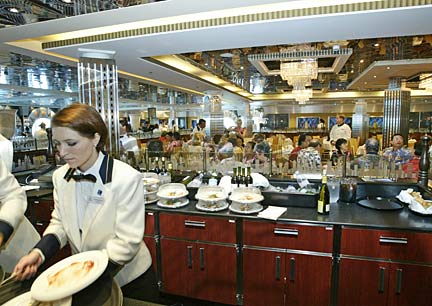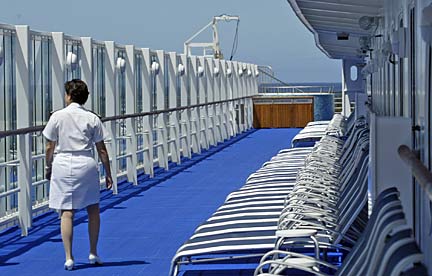
|
Cruise control
Norwegian Cruise Line expects to attract
8,000 passengers a week, employ 3,000 people
and generate $50 million in annual taxes after
the third of its three ships arrives next summer
Hawaii's cruise ship industry floundered in the days following the Sept. 11, 2001, terrorist attacks, as the state's sole interisland cruise operator was flooded with cancellations while bookings plummeted by 50 percent.
American Classic Voyages Inc. filed for bankruptcy protection just 38 days after the attack and shut down its Hawaii operations, scuttling plans for two new ships.
Since then, however, the Hawaii cruise ship industry has made an aggressive recovery. It has seen unprecedented growth, led by Norwegian Cruise Line and fueled by vacation-starved baby boomers.
What used to be a seasonal business with a few ships making calls here, is now a year-round mainstay with Hawaii's ports bustling with activity.
"For us, it's a huge market," said Robert Kritzman, NCL's executive vice president and managing director of Hawaii operations. "Very few people have cruised Hawaii. There's an untapped market still there and Hawaii is a phenomenal place to come through."

Pride of America passengers come ashore at the pier in Kona.

Paulette Greenway works a server station while lunch is served at the Skyline Restaurant aboard the Pride of America.
Jacqueline Traves, group services coordinator on the Pride of America, walks amid dozens of lounge chairs.
The 1,900-passenger Pride of Aloha was the first, introduced last summer. Formerly the Norwegian Sky, it was redesigned with a Hawaii theme and reflagged to a U.S. vessel, allowing it to carry passengers solely between U.S. ports.
The brand new 2,100-passenger Pride of America made its debut in June as the largest U.S.-flagged cruise ship ever. By the time its sister ship, the Pride of Hawaii, is built and arrives next summer, the company will have three year-round lavish cruise ships -- as well as a seasonal foreign-flagged vessel -- carrying an estimated 8,000 passengers per week.
"Being able to welcome an additional 8,000 people on a weekly basis will allow us to continue to grow our economy because we are almost at our capacity where our land-based accommodations are concerned," said Marsha Weinert, the state's tourism liaison.
In July, Hawaii hosted 22,725 cruise ship passengers, up 57 percent from July 2004, according to the latest state figures.
Hawaii had 151,164 cruise passengers this year through July, up 34.6 percent from the first seven months of last year. About two-thirds of the visitors are extending their vacations and staying a couple days in hotels or time-share units.
John Hansen, president of the North West Cruiseship Association, projects the number of cruise ship passengers in Hawaii will exceed 400,000 next year, up from about a peak of 150,000 annually before the 2001 terrorist attacks.
However, the rapid growth can be seen worldwide.
In 2004, nearly 10.5 million people took a vacation cruise, an increase of nearly 40 percent from 2001, according to figures on the Cruise Lines International Association's Web site.
Hansen said that five years ago there were just four key cruise ports: Los Angeles; Miami; Fort Lauderdale, Fla.; and Vancouver, British Columbia.
Today, there are more than 20 key homeports that have emerged including Honolulu; Seattle; San Francisco; San Diego; Boston; Baltimore; Norfolk, Va.; Jacksonville, Fla.; and New Orleans.
Many states are pouring millions of dollars into upgrading their cruise facilities to cash in on the cruise boom.
Kritzman said a major benefit of a cruise vacation is value. Included in the fare are transportation, lodging, food and entertainment.
"We think it's a great way to see Hawaii, especially for the first-time visitor," he said. "They get to see all four major islands while packing and unpacking once."
The ships also provide a unique vantage point of the islands, sailing sail past the glowing lava fields of Kilauea volcano on the Big Island, the remote green peaks of the Na Pali coast on Kauai's North Shore and the urban cityscape of Oahu.
Kritzman said the growth wouldn't have been possible without federal legislation enacted after the terrorist attacks. The law exempts NCL's ships from a rule that prohibits foreign-built ships from operating between U.S. ports.
It also requires the cruise line to employ American crews and abide by all U.S. labor laws, including paying overtime. NCL estimates that labor on a U.S. vessel costs more than three times that of a foreign-flagged vessel.
The exemption has been a jackpot for Hawaii.
NCL estimates it will employ 3,000 people and pay about $50 million annually in state taxes and fees when its final ship is operational. That doesn't include the millions generated by income taxes paid by crew members.
"I can't say I'm happy about that, but Gov. (Linda) Lingle should be," Kritzman said.
But not everyone has been a fan of the cruise ships.
Environmentalists say cruise ships harm Hawaii's sensitive ecosystem, including its pristine coral reefs, and threaten the rural charm of the islands. They have long complained about a lack of oversight and laws regulating the cruise ship industry in Hawaii.
"This is not Florida. This is a fragile island that is creaking under the weight of people," said Cha Smith, executive director of KAHEA, an advocate for environmental and native Hawaiian causes.
KAHEA is working on launching a program called, "Na Maka O Ke Kai," or the "Eyes of the Ocean," encouraging people to report fouled water or debris left behind by cruise ships, which they call "giant floating cities."
Kritzman said his state-of-the-art ships go far beyond what is required by law. The ships are self-sufficient, each generating its own electricity and drinking water. The vessels also treat sewage through a high-tech filtration process with the sludge heated and dried to be offloaded or burned in the ship's incinerator.
"I think this is a very low-impact form of tourism. We think this does not have the same impact as building a resort," Kritzman said.
E-mail to Business Desk
[News] [Business] [Features] [Sports] [Editorial] [Do It Electric!]
[Classified Ads] [Search] [Subscribe] [Info] [Letter to Editor]
[Feedback]
